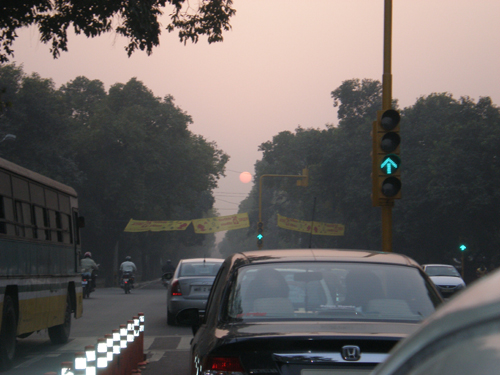Public Transport – I

In any conversation about Delhi contributing to climate change due to CO2 emissions, dominant is the issue of intra-city transport using petrol, CNG and diesel. This contributes over 30% of the city’s emissions and is difficult to reduce.
What is also spoken in the context of our city is the lack of adequate public transport. How we don’t have public transport in the form of buses or railways or water ways. How inta-city transport services at the desired quality, quantity (frequency) and price are lacking so as to make it a preferred option. All kinds of statistics are quoted to substantiate this statement. For exampl, a majority of the poor in the city cannot afford to pay for motorized transport however cheap. They use bicycles or walk to their place of work. A majority of the middle class have at least one motor vehicle, usually a two wheeler that goes 70-80 km per liter. Most, if not al middle class families, now own a car with which goes 14-17 km per liter and takes care of both their need for family outing and daily commute. Then there are ‘contract’ buses for daily commute to work. The rich have more than one car and they use them all.
We all know what is missing is the incentive to use public transport for daily commute as a preferred option. Hence what needs to be done: make it more cheap, more comfortable, and more desirable, than any other mode of transport including walking. The Metro where it exists has worked exactly for this reason. This may be done by making all other modes of transport in comparison to public buses more expensive, through high taxes on private vehicles, and cess on petrol and diesel, and traffic management though carbon pricing etc. We all know these politically correct economic answers and yet they are not being chosen.
A person moves to the city first and foremost to earn money that he can send ‘home.’ Subsequently, they continue to stay for better services and quality of life. What they are already doing in the context of city transport, is the best outcome, given the situation. Hence the problem is only partially economic, there are other dimensions, cultural, political and behavioral. What is required is creating a new possibility in the area of transport, such that people are moved and inspired to take actions and support the transformation (not change) created by this new possibility. After all change persists and is inevitable.




You are wrong in adopting the ‘stick’ policy first. It has to be ‘carrot’ policy. Unfortunately, public transport is zilch in delhi. If private cars are banned (for example) folks would be stranded on roads. Metro, to some extent, will ease out traffic situation. Some ‘vision’ is needed to improvise public transport in delhi.
Hi,
I lvoed reading this article. I totally support public transport. I currently drive to work from south extension to kalkaji. But i wish i had a reliable public transport which i could take instead. Public transport has so many advantages. the most important one beign that you save a lot of nations fuel. but it is so convinient. no hassle of driving, parking etc..Plus a little bit of walking from bus-stop to work will also do good to our health. the city must be made more bus/ metro & walking friendly. it’ll do good in more ways than one!!
Neetika Jain